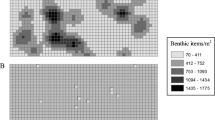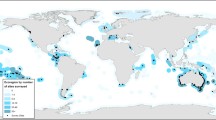Abstract
Twelve terrestrial and marine studies were conducted at various sites in Malaysia, Brazil, and the United States between April 1999 and February 2004. These data were analyzed using five density estimate techniques for stationary (non-motile) organisms including Stratified Random Sampling, Point-Center Quarter, Third Nearest Object, Weinberg, and Strong. The Strong method gave the most accurate density estimates of stationary animals and plants. Stratified Random Sampling ranked second best and the Third Nearest Object the third best. Belt or strip transects may be preferable but can be restrictive in some situations because of logistics and associated time constraints. Straight line measurements on reefs were 3–27% more accurate than reef slack line and reef contour measurements. Most study areas measured with the standardized Morisita index of dispersion were moderately aggregated. Results from the Third Nearest Object and Point-Center Quarter techniques indicate that the addition of more data to establish a density correction factor does not necessarily give more accurate estimates of density.
Similar content being viewed by others
Abbreviations
- SRS:
-
Stratified Random Sampling
- PCQ:
-
Point-Center Quarter or Point-Quarter
- 3NO:
-
Point to Third Nearest Object
References
Bakus GJ (2006) Quantitative Analysis of Marine Biological Communities: Field Biology and Environment. John Wiley & Sons, New York (in press)
Bakus GJ, Hajdu E, Pinheiro US Nishiyama G (2004) Density measurements for biodiversity studies: the sponge Polymastia janeirensis (Boury-Esnault, 1973) from Brazil. In: Pansini M, Pronzato R, Bavestrello G, Manconi R (eds) Bollettino Musei Istituti Biologici, Univ. Genoa 68, 2003:195–200
Bakus GJ, Nishiyama GK (1999) Sponge distribution and coral reef community structure off Mactan Island, Cebu, Philippines. Memoirs Queensland Museum 44:45–50
Barbour MG, Burk JH, Pitts WD, Gilliam FS, Schwartz MW (1999) Terrestrial Plant Ecology. Addison-Wesley-Longman, Menlo Park
Bouchon C (1981) Comparison of two quantitative sampling methods used in coral reef studies: The line transect and the quadrat methods. In: Gomez ED, Birkeland CE, Buddemeier RW, Johannes RE, Marsh JA, and Tsuda RT (eds) The Reef and Man, p. 375 (Abstract). Proceedings 4th International Coral Reef Symposium, 18–22 May 1981, Manila, Philippines. University of the Philippines, Quezon City, Luzon, Philippines
Buckland ST, Anderson DR, Burnham KP, Laake JL, Borchers DL Thomas L (2001) Introduction to Distance Sampling: Estimating Abundance of Biological Populations. Oxford University Press, Oxford
Dethier MN, Graham ES, Cohen S, Tear LM (1993) Visual versus random-point percent cover estimations: ‘objective’ is not always better. Mar Ecol Prog Ser 96:93–100
Engeman RM, Sugihara RT (1998) Optimization of variable area transect sampling using Monte Carlo simulation. Ecology 79(4):1425–1434
Krebs, CJ (1999) Ecological Methodology. Addison-Wesley-Longman, Menlo Park
Krebs CJ (2000) Programs for Ecological Methodology. Department of Zoology, University of British Columbia, Vancouver, British Columbia, Canada
Mitchell K (2001) Quantitative analysis by the Point-centered Quarter method. http://people.hws.edu/mitchell/PCQM.pdf. Cited 19 July 2001. Contact: Mitchell@hws.edu
Southwood R, Henderson PA (2000) Ecological Methods. Blackwell Publishing, Williston
Strong CW (1966) An improved method of obtaining density from line transect data. Ecology 47:311–313
Sutherland WJ, (eds) (1996) Ecological Census Techniques A Handbook. Cambridge University Press, Cambridge
Thompson SK (2002) Sampling. John Wiley & Sons, New York
Underwood AJ (1976) Nearest neighbor analysis of spatial dispersion of intertidal prosobranch gastropods within two substrata. Oecologia (Berlin) 26:257–266
Warde W, Petranka JW (1981) A correction factor table for missing point- center quarter data. Ecology 62:491–494
Weinberg S (1981) A comparison of coral reef survey methods. Bijdrigen tot de Dierkunde 51(2):199–218
Wright MT, Bakus GJ, Ortiz A, Ormsby B, Barnes D (1991) Computer image processing and automatic counting and measuring of fouling organisms. Comput Biol Med 21:173–180
Acknowledgments
The authors are grateful to the following people for their help in the field: Grace Bakus, Josiane Rocha, Tara Crow, Ryan Canova, students of Dr. Zulfigar in Malaysia (Sazlina Md. Salleh, Siti Zaama Rizal Boss, Yuhana Ubong) and students of Gerald Bakus at Southern Oregon University, Ashland in Oregon (Pete Hill, Andy Mackinnon, Jed Henderson, Levi Kleiber, Allen Zachary, William Burns, Peder Nelson). Mike Cusi (Philippines) and Muhd Hanif b. Hosainel Majidi (Malaysia) identified hard corals for which we are grateful. Fellowships and grants by CNPq and FAPESB for E. Hajdu and U.S. Pinheiro, respectively, are much appreciated. Steve Buckland and William Sutherland kindly reviewed the manuscript and made many valuable suggestions for improvement.
Author information
Authors and Affiliations
Corresponding author
Appendix
Appendix
Rights and permissions
About this article
Cite this article
Bakus, G.J., Nishiyama, G., Hajdu, E. et al. A comparison of some population density sampling techniques for biodiversity, conservation, and environmental impact studies. Biodivers Conserv 16, 2445–2455 (2007). https://doi.org/10.1007/s10531-006-9141-7
Received:
Accepted:
Published:
Issue Date:
DOI: https://doi.org/10.1007/s10531-006-9141-7




